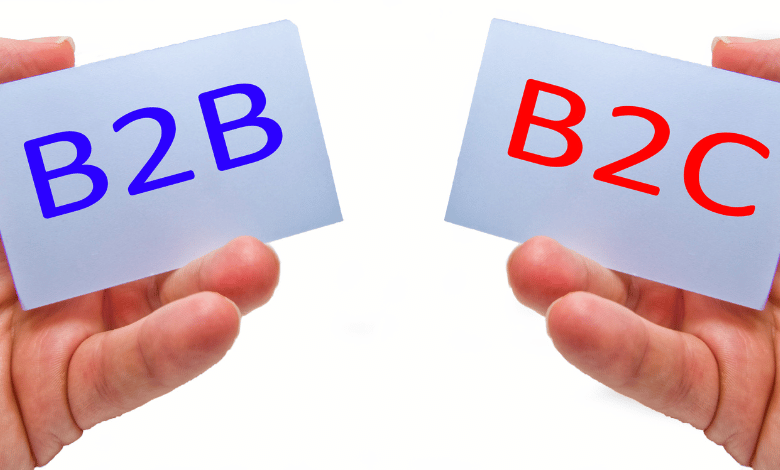If you are running a business, should you focus on B2B or B2C marketing? That is a crucial topic for a business owner or an entrepreneur to think about before making any decisions any marketing decision for their business.
However, to make the best choice between B2B and B2C marketing, you must understand how they differ.
What Are the Differences Between B2B and B2C?
B2B and B2C marketing strategies are geared toward luring distinct target groups of consumers and businesspeople.
Businesses dedicated to providing their services to other companies are called “B2B.” Some of the examples of B2B include software, manufacturing equipment, and repair services.
Companies that respond to their client’s requirements and desires, typically individuals, are referred to as “businesses to consumer (B2C).” Some examples of B2C include grocery, bakery, gaming, etc.
So, what are the differences between B2B and B2C;

Expected sales volume
B2C marketing efforts can communicate with anyone interested in a product, regardless of whether or not they are the targeted buyer. For instance, a product geared toward children may also target the guardian who makes the purchasing decisions to persuade that person to buy something.
B2C enterprises can run broad campaigns and anticipate a healthy return on investment (ROI), but B2B brands do not have this luxury. This is because, in business-to-business marketing, the products being sold are intended for use in firms, and there are normally a far smaller number of businesses than individuals in any population.
Average cost per client
The financial resources available to an individual are significantly lower than a firm’s budget. For the average person, shelling out hundreds of dollars for a piece of machinery is probably out of the question, but for a firm, such an expense is likely already factored into the company budget.
Quantity of sales required to achieve the objectives
Because B2C items are usually offered at a lower price point, the companies who sell them must rely on making many sales to accomplish their objectives. This is frequently reflected in the regularity and diversity of their marketing. Advertisements broadcasted on podcasts paid posts on social media platforms, and even billboards are all great examples of B2C channels used to reach as many people as possible.
On the other hand, business-to-business (B2B) items are sold at a higher price range and require a smaller number of more specifically targeted accounts. The success of these kinds of initiatives is predicated not so much on reaching the desired number of audience members as they are on reaching the desired quality of audience members. To put it another way, in business-to-business marketing, having more is not always preferable.
Timelines in decision making
Ads in business-to-business and business-to-consumer marketing ought to instantly encourage clients to take the next move. The distinction lies in that the following step for B2C viewers may be to buy an item, whereas the decision-making process for B2B buyers is typically significantly longer.
When it comes to business-to-consumer transactions, customers should be allowed to view an advertisement and determine whether they are interested in the goods enough to make a purchase either in-person or online. Even if customers conduct further research, the time required to read reviews or see product videos on YouTube is significantly less than the amount of time spent on B2B purchases.
Regarding B2B brands, the acquisition process may involve multiple decision-makers from various departments. Typically, several budget approvals and discussions occur between the initial viewing of an advertisement by a firm and the ultimate purchase.
Logic and emotions
Business-to-consumer marketing (B2C) also uses emotional appeals to facilitate quick purchasing decisions. This indicates that the information they produce is typically more enjoyable or entertaining. Consider films posted on TikTok and YouTube and compensated sponsorships on social media.
The objective of B2B marketers is frequently to advance their prospects to the next phase of the sales funnel. This could involve anything from arranging a free trial to establishing subscriptions. B2B marketers must determine which programs will target certain marketing funnel stages. This allows them to reach the appropriate audience at the right time with the correct message.

B2B and B2C: Which One Should You Choose?
When deciding between business-to-business marketing and business-to-consumer marketing, you need to consider the people you intend to sell to. Once more, everything revolves around corporations as opposed to individuals. You can run distinct marketing campaigns that combine B2B and B2C marketing strategies if your target demographics include customers from both the business and consumer worlds.
Budget is also a factor to consider. Customarily, B2C marketing casts a larger hook throughout networks, channels, and ad formats. If you can reach the public through various channels, B2C marketing should be explored.
The business-to-business marketing technique is the way to go if you have a limited marketing budget or a specialized product. Although it may require extra planning, this approach makes it simple to contact leads with a good return on investment.
Check More Of Our Content Down Below
110 Motivational Quotes For Your Entrepreneurial Spirit
What Is The Cost Of SEO Service – Detailed?
